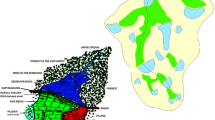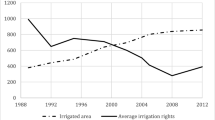Abstract
In the context of increased competition for water, growing more rice with less water will be one of the major challenges of the 21st century. This paper examines water savings and issues of scale in water productivity. The main objective is to understand if and how field-scale interventions scale up to subbasin-scale water savings in the Zhanghe Irrigation District (ZID) in Hubei Province, central China. Our results confirmed that on-farm water-saving practices result in higher water productivity per unit of irrigation water at the field scale due to lower irrigation water input. However, the question is, if these field-scale practices have led to “real” water savings; savings which can be transferred to other agricultural and non-agricultural uses without lowering existing production levels. To investigate this question, we examined water use and productivity at four different scales: field scale, meso scale, main canal command scale, and subbasin scale using the water accounting methodology. The study clearly demonstrates the high dependence on the scale of water use and productivity parameters. Depleted fraction and water productivity per unit of gross inflow and irrigation water varied dramatically across scale. Thus, it is not possible to conclude from field-scale observations that basin level water savings will or will not take place. The major reasons for these scale effects are the lateral flow of water across boundaries, differing land use patterns across scales, and changing water management patterns across scales. In the ZID, going from field and meso scale to even larger scales, water productivity per unit of irrigation increases to even higher levels than at the field scale. Here it becomes clear that the ZID, with its possibilities of reuse of drainage return flows and capturing rainfall and runoff in all the reservoirs within the system, is very effective in capturing and using water productively. Factors that influence water productivity and depleted fraction are on-farm water savings as well as the reuse of drainage water, effective capturing and utilization of rain, and canal water management. The scope for additional real water savings in the Zhanghe Irrigation District is limited. Only 13% of the combined rainfall and Zhanghe reservoir irrigation water releases flow out of the basin. A further reduction in drainage surface outflow from the ZID may have negative downstream effects on other water uses, including environmental uses. The main lessons learned are that (1) employing a combination of factors—on-farm practices, reuse, and canal operations—can be an effective means of conserving water resources within irrigation systems, (2) the scope for savings must be considered by an analysis at larger scales (i.e. irrigation system or basin scale), and may be less than thought because of the interactions of these factors. The results clearly indicate that scale effects are important for understanding and planning for water savings and water productivity.



Similar content being viewed by others
References
Allen RG, Pereira LS, Raes D, Smith M (1998) Crop evapotranspiration: guidelines for computing crop water requirements. FAO Irrigation and Drainage Paper 56. FAO, Rome, 300 pp
Bastiaanssen WGM, Menenti M, Feddes RA, Holtslag AAM (1998) A remote sensing surface energy balance algorithm for land (SEBAL). J Hydrology 212/213:198–212
Bastiaanssen WGM, Ali S (2003) A new crop yield forecasting model based on satellite measurements applied across the Indus Basin, Pakistan. J Agri Ecosys Environ 94:321–340
Belder, P, Bouman BAM, Cabangon R, Lu Guoan, Quilang EJP, Li YH, Spiertz JHJ, Tuong TP (2004) Effect of water-saving irrigation on rice yields and water use in typical lowland conditions in Asia. Agri Water Manage 65(3): 93–210
Cabangon RJ, Castillo EG, Bao LX, Lu G, Wang GH, Cui YL, Tuong TP, Bouman BAM, Li YH, Chen CD, Wang JZ (2001) Impact of alternate wetting and drying irrigation on rice growth and resource-use efficiency. In Barker R, Loeve R, Li YH, Tuong TP (eds) Water-saving irrigation for rice: proceedings of an international workshop held in Wuhan, China. 23–35 March 2001, International Water Management Institute, Colombo, Sri Lanka, pp 55–79
Chemin Y, Ahmad MD (2000) Estimating evaporation from surface energy-balance model (SEBAL): a manual for NOAA AVHRR in Pakistan. IWMI-Pakistan Report no. 102, IWMI-Pakistan, Lahore
Chemin Y, Alexandridis T (2001) Improving spatial resolution of ET seasonal for irrigated rice in Zhanghe, China. Asian Conference of Remote Sensing 2001, November 2001, National University of Singapore, Singapore, 8 pp
Dong B, Molden D, Loeve R, Li YH, Chen CD, Wang JZ (2004) Issues of scale in water productivity in Zhanghe Irrigation System: farm level practices—Are farmers saving water? J Paddy Water Environ (in press)
Dong B, Loeve R, Li YH, Chen CD, Deng L, Molden D (2001) Water productivity in Zhanghe Irrigation System: issues of scale. In Barker R, Loeve R, Li YH, Tuong TP (eds) Water-saving irrigation for rice. Proceedings of an International Workshop held in Wuhan, China, 23–35 March 2001, International Water Management Institute, Colombo, Sri Lanka, pp 97–115
FAO (2003) FAO aquastat. http://www.fao.org
IWMI (International Water Management Institute) (2000) World water and climate atlas. , IWMI, Colombo, Sri Lanka,http://www.iwmi.org
Keller A, Keller J (1995) Effective efficiency: a water use efficiency concept for allocating freshwater resources. Discussion Paper 22, Winrock International, Center for Economic Policy Studies, Water Resources and Irrigation Division, Arlington, Virginia
Li SX, Lu CB, Wang ZG (1998) Spreading water saving irrigation for rice, promote sustainable development of agriculture (In Chinese, with English abstract). China Rural Water Hydropower 11:1–6
Li YH, Ni WJ, Chen CD (2003) Strategies for managing water scarcity in rice production areas in China. In: Mew TW, Brar DS, Peng S, Dawe D, Hardy B (eds) Rice science: innovations and impact for livelihood. Proceedings of the International Rice Research Conference, 16–19 September 2002, Beijing, China. International Rice Research Institute, Chinese Academy of Engineering, and Chinese Academy of Agricultural Sciences, Beijing, China, pp 507–517
Li YH (ed) (1999) Theory and techniques of water saving irrigation (In Chinese). Wuhan University of Hydraulic and Electrical Engineering, Wuhan, China, 310 pp
Li YH, Dong B, Yu F (1999) Improving irrigation management of paddy fields for sustainable increases in water productivity. In: Musy A, Pereira LS, Fritsch M (eds) Emerging technologies for sustainable land use and water management. Proceedings of the 2nd Inter-Regional Conference on Environment-Water, 1–3 September 1999, Publ. Presses Polytechniques et Universitaires Romandes, Lausanne, Switzerland, 36 pp
Li YH, Cui YL (1996) Real-time forecasting of irrigation water requirements of paddy fields. Agri Water Manage 31(3):185–193
Loeve R, Hong L, Dong B, Guo Mao, Chen CD, Dawe D, Barker R (2004) Long term trends in intersectorial water allocations and crop water productivity in Zhanghe and Kaifeng, China. J Paddy Water Environ (in press)
Loeve R, Dong B, Zhao JH, Zhang SJ, Molden D (2001) Operation of the Zhanghe Irrigation System. In Barker R, Loeve R, Li YH, Tuong TP (eds) Water-saving irrigation for rice. Proceedings of an International Workshop held in Wuhan, China 23–35 March 2001, International Water Management Institute, Colombo, Sri Lanka, pp 25–53
Maclean, JL, Dawe DC, Hardy B, Hettel GP (2002) Rice almanac, 3rd edition. International Rice Research Institute, Los Baňos, Philippines, 253 pp
Mao Z (1993) Principle and technique of water-saving irrigation for rice (In Chinese). Wuhan University of Hydraulic and Electrical Engineering, Wuhan
Mao Z (1997) Water saving irrigation for rice. China Rural Water Hydropower 4:45–47
Mao Z (1992) Calculation of evapotranspiration of rice. In: Proceedings of International Workshop on Soil and Water Engineering for Paddy Field Management, January 1992, Bangkok, Thailand, pp21–34
Molden D (1997) Accounting for water use and productivity. SWIM Paper 1. International Water Management Institute, Colombo, Sri Lanka, 16 pp
Molden D, Sakthivadivel R (1999) Water accounting to assess use and productivity of water. Water Resources Development 15(1):55–71
Moya P, Hong L, Dawe D, Chen CD (2001) Comparative Assessment of On-farm Water-Saving Irrigation Techniques in the Zhanghe Irrigation System. In: Barker R, Loeve R, Li YH, Tuong TP (eds) Water-saving irrigation for rice. Proceedings of an International Workshop held in Wuhan, China 23–35 March 2001, International Water Management Institute, Colombo, Sri Lanka, pp 81–96
Peng SZ, Yu SE, Zhang HS (1997) Water saving irrigation techniques for paddy (In Chinese). China Water and Hydro, Beijing, China, 155 pp
Rijsberman FR, Molden D (2001) Balancing water uses: water for food and water for nature. Thematic background paper. International Conference on Freshwater. December 2001, Bonn, Germany, 18 pp
Seckler D (1996) The new era of water resources management: from “dry” to “wet” water savings. Research Report 1. International Irrigation Management Institute (IIMI), Colombo, Sri Lanka, 17 pp
Tasumi M, Bastiaanssen WGM, Allen RG (2000) Application of the SEBAL methodology for estimating consumptive use of water and stream flow depletion in the Bear River Basin of Idaho through remote sensing. Appendix C: a step-by-step guide to running SEBAL. Final Report, EOSDIS Project, The Raytheon Systems Company, Waltham, Massachusetts
Tuong TP, Bhuiyan SI (1999) Increasing water-use efficiency in rice production: farm-level perspectives. Agri Water Manage 40(1):117–122
Wang GT (1992) High-yield and water-saving irrigation method: deep-thin-alternate dry and wet (In Chinese, with English abstract). Irrig Drainage Small Hydropower Sta 8:18–19
Wu JS (1998) Novel combination scheme of efficient water use in rice region of south China (In Chinese, with English abstract). China Rural Water Hydropower 9:7–9
Acknowledgments
This research is part of the projects “Impact of Water-Saving Irrigation Techniques in China” and “Growing more rice with less water” funded by the Australian Centre of International Agricultural Research. The research is conducted by a team of scientists and practitioners from Wuhan University, the Zhanghe Irrigation Administration Bureau, the International Rice Research Institute (IRRI) in the Philippines, and the International Water Management Institute (IWMI) in Sri Lanka.
Author information
Authors and Affiliations
Corresponding author
Rights and permissions
About this article
Cite this article
Loeve, R., Dong, B., Molden, D. et al. Issues of scale in water productivity in the Zhanghe irrigation system: implications for irrigation in the basin context. Paddy Water Environ 2, 227–236 (2004). https://doi.org/10.1007/s10333-004-0061-4
Received:
Accepted:
Published:
Issue Date:
DOI: https://doi.org/10.1007/s10333-004-0061-4




